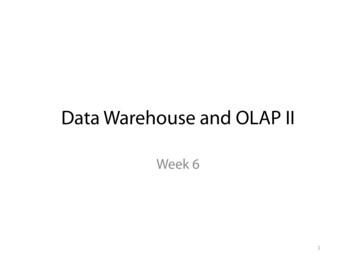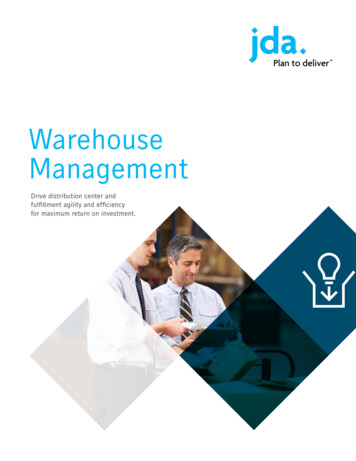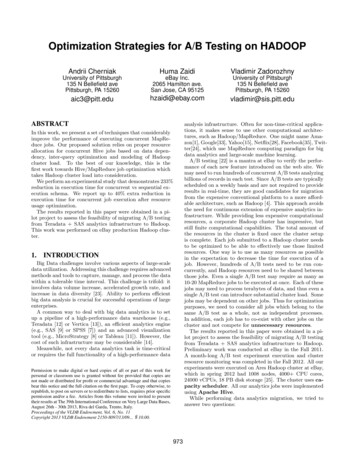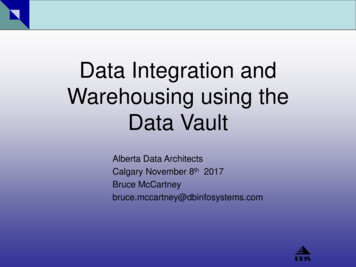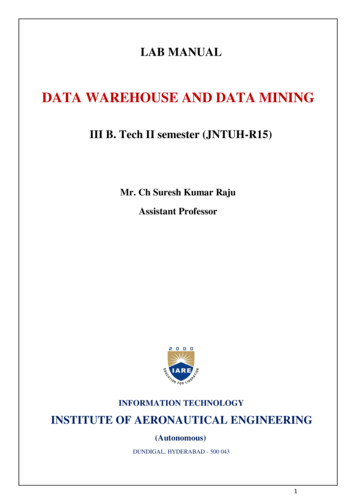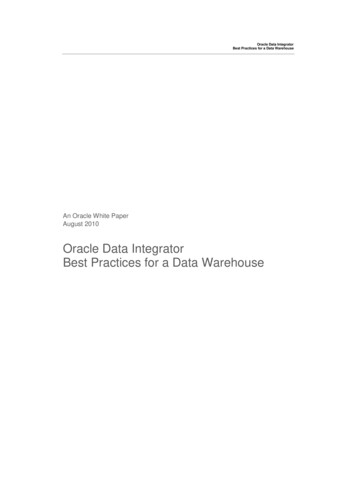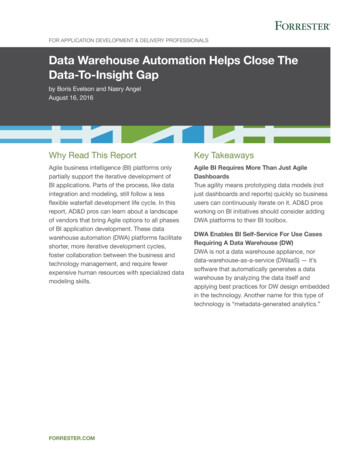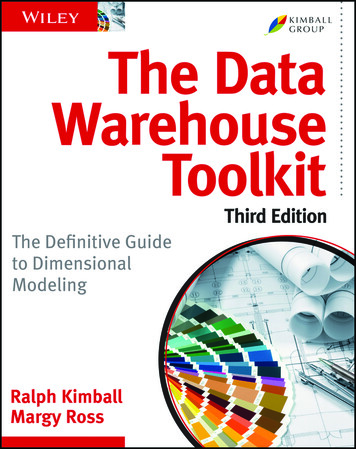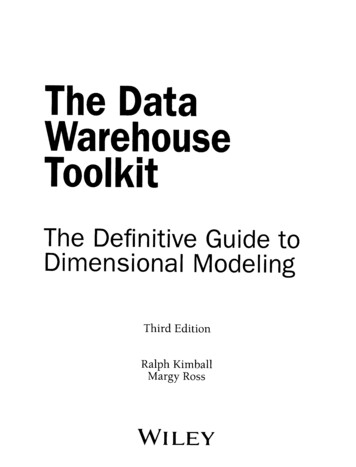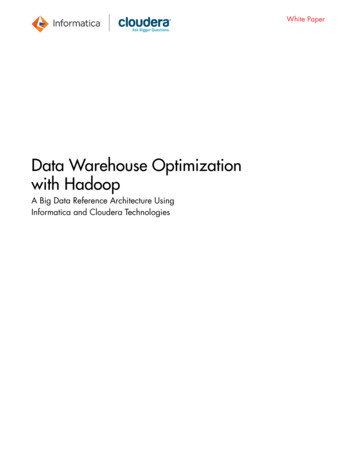
Transcription
White PaperData Warehouse Optimizationwith HadoopA Big Data Reference Architecture UsingInformatica and Cloudera Technologies
This document contains Confidential, Proprietary and Trade Secret Information (“ConfidentialInformation”) of Informatica Corporation and may not be copied, distributed, duplicated, or otherwisereproduced in any manner without the prior written consent of Informatica.While every attempt has been made to ensure that the information in this document is accurate andcomplete, some typographical errors or technical inaccuracies may exist. Informatica does not acceptresponsibility for any kind of loss resulting from the use of information contained in this document.The information contained in this document is subject to change without notice.The incorporation of the product attributes discussed in these materials into any release or upgrade ofany Informatica software product—as well as the timing of any such release or upgrade—is at the solediscretion of Informatica.Protected by one or more of the following U.S. Patents: 6,032,158; 5,794,246; 6,014,670;6,339,775; 6,044,374; 6,208,990; 6,208,990; 6,850,947; 6,895,471; or by the followingpending U.S. Patents: 09/644,280; 10/966,046; 10/727,700.This edition published January 2014
White PaperTable of ContentsExecutive Summary . . . . . . . . . . . . . . . . . . . . . . . . . . . . . . . . . . . . . . 2The Need for Data Warehouse Optimization . . . . . . . . . . . . . . . . . . . . 3Real-World Use of Data Warehouse Optimization . . . . . . . . . . . . . . . . 4Informatica and Cloudera Converge on Big Data . . . . . . . . . . . . . . . . . 4Seven Key Processes for Data Warehouse Optimization . . . . . . . . . . . 5A Reference Architecture for Data Warehouse Optimization . . . . . . . . . 6Universal Data Access . . . . . . . . . . . . . . . . . . . . . . . . . . . . . . . . . . . . . . . . . . . 7Flexible Data Ingestion . . . . . . . . . . . . . . . . . . . . . . . . . . . . . . . . . . . . . . . . . . . 8Streamlined Data Pipeline Design and Execution . . . . . . . . . . . . . . . . . . . . . . . . . 9Scalable Data Processing and Storage . . . . . . . . . . . . . . . . . . . . . . . . . . . . . . . 10End-to-End Data Management . . . . . . . . . . . . . . . . . . . . . . . . . . . . . . . . . . . . . 12Real-Time Interactive Queries . . . . . . . . . . . . . . . . . . . . . . . . . . . . . . . . . . . . . . 13Enterprise Accountability, Control, and Governance . . . . . . . . . . . . . . . . . . . . . . 14The Safe On-Ramp to Data Warehouse Optimization . . . . . . . . . . . . . 17Data Warehouse Optimization with Hadoop: A Big Data Reference Architecture Using Informatica and Cloudera Technologies1
Executive SummaryTraditional data warehouse environments are being overwhelmed by the soaring volumes and wide variety ofdata pouring in from cloud, mobile, social media, machine, sensor, and other sources. And the problem willonly worsen as big data continues to grow. IT organizations that need to address performance degradationin warehouses approaching their capacity are already considering costly upgrades. However, an upgrade isnot the most effective way to manage an excess of seldom-used data. Nor does it save valuable CPU cyclescurrently consumed by the need to execute compute-intensive extract, load, and transform (ELT) jobs. To keeppace with exploding data volumes, the data warehouse itself needs to evolve.One emerging strategy is data warehouse optimization using Hadoop as an enterprise data hub to augmentan existing warehouse infrastructure. By deploying the Hadoop framework to stage and process raw or rarelyused data, you can reserve the warehouse for high-value information frequently accessed by business users.This white paper outlines a new reference architecture for this strategy, jointly developed by Informatica andCloudera to help organizations speed time to value, maximize productivity, lower costs, and minimize risk.Leveraging complementary technology from Informatica, the leading provider of data integration software,and Cloudera, the leader in enterprise analytic data management powered by Apache Hadoop , thisreference architecture supplies a blueprint for augmenting legacy warehouses to increase capacity andoptimize performance. It enables organizations to better capitalize on the business value of big data.2
The Need for Data Warehouse OptimizationToday’s information-driven business culture challenges organizations to integrate data from a wide variety ofsources to improve customer acquisition and retention, increase operational efficiencies, strengthen productand service delivery, and enter new markets. To meet these goals, enterprises demand accessible, timely,actionable data—plus analytical environments that can scale to the tremendous growth in data volume,variety, and velocity while also handling diverse types of enterprise data processing workloads.Today’s data warehouses, however, aren’t up to the challenge of meeting these new demands. As datavolumes and business complexity increase, the traditional “scale up and scale out” approach of addinginfrastructure using high-end servers or appliances with expensive shared storage (e.g., SAN or NAS) hasbecome impractical and far too costly. IT and business leaders must rethink their warehousing strategies toaddress the inadequacies of existing systems. These inadequacies include the following five issues:Low-value data that consumes warehouse space. Over time, many warehouses have become bloated withboth raw data staged for preprocessing and rarely accessed data that provides little business value.Inadequate data for business demands. Because of capacity and performance constraints, some warehousescontain only summary data, not the granular and detailed information that the business needs. Users becomefrustrated when they are unable to access the data necessary to address business questions.In-warehouse transformations that impair performance. Running data transformations within a warehouse ondata staged for preprocessing (i.e., ELT) consumes valuable CPUs, hindering query performance and furtherdiminishing a warehouse’s business value.Network performance that bottlenecks in grids. In grid computing environments, the network can become abottleneck when large data volumes are pushed to CPU workloads, limiting how much data can be processedin a reasonable time.Limitations in multi-structured data and schema flexibility. Warehouses based on relational databases are notbuilt to handle the multi-structured datatypes from new big data sources, while schema changes can triggerdisruptions and delays.Data Warehouse Optimization with Hadoop: A Big Data Reference Architecture Using Informatica and Cloudera Technologies3
Real-World Use of Data Warehouse OptimizationAugmenting legacy data warehouses with Hadoop-based solutions optimizes data warehouses, helpingto deliver timely data while lowering costs, increasing performance, and meeting the business demands ofterabyte- and petabyte-scale big data in virtually every industry—finance, telecommunications, retail, Internet,utilities, oil and gas, healthcare, pharmaceuticals, media and entertainment, and the public sector.Leading organizations are already putting the Informatica /Cloudera solution to work:A large global financial services and communication company is cost-effectively scaling the access, storage,and processing of hundreds of terabytes of data from 18 diverse sources. The company, which processes650 million transactions a year, is improving customer service across 25 global call centers, reducing fraud,identifying trends to guide business decisions, and enhancing product development.A large U.S. government agency facing a fivefold increase in data volumes in the next few years found that 60percent of its warehouse data was dormant and that 40 percent of CPU capacity was consumed by ELT. Ratherthan spend millions on infrastructure, the healthcare-related agency uses Informatica and Cloudera to managedata integration across multiple sources, processing up to 25 billion records a day.A global media and entertainment company faced data delivery delays and exorbitant costs in its traditionalwarehouse as its data increased 20 times annually. With data warehouse optimization, the companyanticipates reducing data storage costs by up to 100%, speeding data delivery from 48 hours to 15 minutes,and gaining a 360-degree customer view.Informatica and Cloudera Converge on Big DataCloudera Chief Architect Doug Cutting founded the Apache Hadoop project in 2006 to offer enterprises away to store and process large volumes of data for Web indexing. The use of Hadoop was compelling fordata warehouse optimization which emerged later. The open-source Hadoop framework enables fault-tolerant,distributed parallel processing and storage of huge amounts of multi-structured data across highly availableclusters of low-cost commodity servers. Hadoop is ideally suited for large-scale data processing, storage, andcomplex analytics, often at just 10 percent of the cost of traditional systems.In the early days of Hadoop, developers had to hand code data integration workloads in new languages.Although Hadoop enabled enterprises to reduce infrastructure costs, the limited availability and high costof Hadoop developers diminished the value proposition. In 2010, Informatica and Cloudera formed apartnership to create data integration tools for Hadoop. Today, Informatica offers a set of Hadoop-native toolsfor codeless development and execution of ETL, data integration, and data quality flows.4
With Informatica and Cloudera technology, enterprises have improved developer productivity up to five timeswhile eliminating errors that are inevitable in hand coding. Informatica’s visual development environment letsenterprises reuse existing Informatica skills for Hadoop big data projects with no further training, substantiallyincreasing return on investment. If organizations need additional resources, they can draw on a global poolof more than 100,000 developers trained on Informatica, as well as comprehensive training and professionalservices from both Informatica and Cloudera to help reduce cost, speed time to value, and improve projectquality. By leveraging the technologies and skills available from Informatica and Cloudera, enterprises canoptimize data warehouses using Hadoop as an enterprise data hub: Cost-effectively scaling out infrastructure to support unlimited data volumes Leveraging commodity hardware and software to lower infrastructure costs Using existing and readily available skilled resources to lower operational costs Supporting virtually all types of data from both internal and external sources Enabling agile methodologies with schema-on-read, rapid prototyping, metadata-driven visual developmentenvironments, and collaboration tools Integrating with existing and new types of on-premise and cloud infrastructureSeven Key Processes for Data Warehouse OptimizationAs part of their jointly developed reference architecture, Informatica and Cloudera have identified sevenfundamental processes for IT architects to consider in mapping out and implementing a data warehouseoptimization architecture in two phases. Informatica and Cloudera technologies support each of these steps(see Figure 1).1. Offload ELT processing and infrequently used data to Hadoop. This step alleviates the CPU burden on datawarehouses consumed by in-warehouse data transformations in ELT models, and frees space by offloadinglow-value or infrequently used information.2. Batch load raw data to Hadoop. Instead of feeding data from source systems into the warehouse,raw transactional and multi-structured data is loaded directly into Hadoop, further reducing impact onthe warehouse.3. Replicate changes and schemas for data. Entire schemas can be replicated to Hadoop, offloadingprocessing from OLTP and mainframes and operational data stores . Users can further optimize performanceand reduce latency by choosing the option of change data capture to move only newly updatedinformation. Because Hadoop doesn’t impose schema requirements on data, unstructured informationpreviously unusable by the warehouse can be leveraged in Hadoop.4. Collect and stream real-time machine and sensor data. Data generated by machines and sensors, includingapplication and Web log files, can be collected in real time and streamed directly into Hadoop instead ofbeing staged in a temporary file system—or worse, in the warehouse.Data Warehouse Optimization with Hadoop: A Big Data Reference Architecture Using Informatica and Cloudera Technologies5
5. Prepare data for analysis. Within Hadoop, data can be profiled to better understand its structure andcontext. Multi-structured and unstructured data (such as Web logs, JSON, sensor data, call detail records,and FIX, HL7, and other industry-specific information) can be parsed to extract features and entities, anddata quality techniques can be applied. Prebuilt transformations and data quality and matching rules canbe executed natively in Hadoop, preparing data for analysis.6. Execute real-time interactive queries. Cloudera’s Impala enables users to run native, real-time SQL queriesdirectly against Hadoop data, sidestepping real-time query limitations of Hive and MapReduce to explore,visualize, and analyze data to discover interesting patterns and trends.7. Move high-value curated data into the warehouse. After data has been cleansed and transformed inHadoop, high-value data can be moved from Hadoop to the warehouse for direct access by the enterprise’sexisting BI reports, applications, and users.Figure 1. Data warehouse optimization process flow.A Reference Architecture for Data Warehouse OptimizationAt the core of the reference architecture are the Informatica data integration platform, including PowerCenterBig Data Edition and powered by Informatica's embeddable virtual data machine, and CDH, Cloudera’senterprise-ready distribution of Hadoop (see Figure 2). The reference architecture also uses complementarytechnologies of the Informatica Intelligent Data Platform and Cloudera Enterprise, including CDH, theCloudera Manager management console, and the Impala query tool.6
These integrated technologies provide a proven platform for data warehouse optimization, incorporating allthese necessary features: Universal data access Flexible data ingestion Streamlined data pipeline design and execution Scalable data processing and storage End-to-end data management Real-time interactive queries Enterprise accountability, control, and governanceFigure 2. The Informatica/Cloudera data warehouse optimization architecture.Universal Data AccessTo access all the necessary data for processing and move it into Hadoop, developers often resort to buildingcustom adapters and scripts that require expert knowledge of source systems, applications, and datastructures. This labor-intensive hand coding is time-consuming and costly to maintain as software versionschange. If these adapters lack direct connectivity between the source systems and Hadoop, the data mayneed to be staged temporarily, increasing storage costs. Custom coding also can’t always deliver the neededscalability, performance, and reliability, increasing the risk of noncompliance and system downtime.Data Warehouse Optimization with Hadoop: A Big Data Reference Architecture Using Informatica and Cloudera Technologies7
Informatica PowerExchange addresses these issues by accessing data from virtually any source anddelivering it directly to Hadoop — or, conversely, delivering data from Hadoop to an enterprise warehouseand applications. In addition to relational data, PowerExchange can access a broad range of other datatypes,including mainframes, NoSQL databases, social media, machine data, email, Word, PDF, HL7, HTML, andother sources, with no need for developers to custom-code access or address data format differences. Itfurnishes all these necessary capabilities: Universal and secure access to virtually any data source or target Native connectivity for optimal performance Flexible modes of delivery (batch, micro-batch, real time, CDC, replication, streaming) High availability and parallel processing using partitioning and grid computing Easy wizard-driven setup and a single point of administrationFlexible Data IngestionFlexible data movement is a prerequisite for meeting unique business demands, latency requirements, andservice-level agreement (SLA) targets. Informatica supplies a range of technologies to optimize movement ofvarious datatypes between sources, while Hadoop offers unprecedented performance and eliminates the needto temporarily stage copies of data.Batch and micro-batch data load. Conventional data loads enable IT to schedule periodic movements throughInformatica PowerCenter or PowerExchange to Hadoop, with options for partitioning and parallel processingfor greater performance and minimal operational impact.High-speed data replication and CDC. Log-based Informatica Data Replication and CDC software noninvasively replicates data to Hadoop in real time as changes occur in source systems, or to replicate entireschemas or subsets of schemas. Replication lacks the robust transformation capabilities of conventional ETL, butoffers the advantages of real-time updates and high-speed data replication with no disruption to operationalsystems, often in support of operational BI.Real-time data collection and streaming. Informatica Edge Data Streaming (formerly named Vibe Data Stream)gives enterprises a new way to capture data from the “Internet of Things” for delivery to Hadoop or othertargets (see Figure 3). Capable of streaming millions of records per second, the solution enables use ofpreviously hard-to-access machine, sensor, and Web information across industries.8
Figure 3. Real-time data collection and streaming into Hadoop.Streamlined Data Pipeline Design and ExecutionThe visual user interface of Informatica PowerCenter Big Data Edition simplifies the design and execution ofdata pipelines, or mappings, by eliminating the need to know MapReduce, Hive, Pig, or other technologies.Developers can rapidly devise data pipelines to extract, transform, load, and cleanse data to and fromHadoop and execute pipelines without manual intervention.When these data pipelines are deployed and run, Informatica optimizes the end-to-end flow from source totarget by generating Hive query language (HiveQL) scripts. Transformations that don’t map to HiveQL (e.g.,name and address cleansing routines) are run as user-defined functions via Informatica Vibe libraries residingon each Hadoop node.Because design is separated from deployment, existing PowerCenter mappings can be run on Hadoop.Informatica executes all mapping logic natively on Hadoop. The entire end-to-end data pipeline is optimizedfor best performance by rearranging mapping logic for maximum efficiency, using HiveQL as a MapReducetranslation layer and the user defined function (UDF) framework to execute logic that does not translateto HiveQL.Instead of using the Hive server for execution, Informatica achieves maximum performance by only usingoptimized HiveQL scripts as a mechanism to translate SQL-like transformations into MapReduce and to executeUDFs for non-SQL logic such as expression transforms and data quality rules. In other words, the entire datapipeline is executed natively on Hadoop via MapReduce.Data Warehouse Optimization with Hadoop: A Big Data Reference Architecture Using Informatica and Cloudera Technologies9
For data that may not reside on the Hadoop cluster (e.g., reference data, lookups, dimension keys, etc.),Informatica streams the data from the source (e.g., RDBMS) into Hadoop for processing. Resulting data setscan t
A Reference Architecture for Data Warehouse Optimization At the core of the reference architecture are the Informatica data integration platform, including PowerCenter Big Data Edition and powered by Informatica's embeddable virtual data machine, and CDH, Cloudera’
